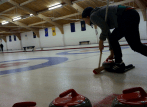
By: Josh Axelrod > Freshman > Journalism > University of Maryland, College Park, Photo by Tracy Apps
Americans have a tendency to scoff at certain sports enjoyed by other countries. One such misunderstood sport is curling, a pastime enjoyed by our neighbors to the north, Canada. While some people will inevitably roll their eyes and make a joke stereotyping Canada at the mention of curling, the sport is gaining a devoted following stateside.
Unbeknownst to most mainstream college sports fans, an organization called College Curling USA “supports a curling program for collegiate curlers and inexperienced curlers at numerous curling clubs around the country,” according to their website, collegecurling.org.
The organization helps those interested in curling start clubs at their schools, provides instructions on the rules of the game, and sponsors the National College Curling Championship. The 20th annual bonspiel (curling tournament) will be held March 11-13, 2011 in Chicago and will feature thirty-two teams that will be competing for gold, silver, and bronze pins in each of their divisions.
For the uninitiated, curling is played on a sheet of ice with four players: a lead, second, vice skip, and skip (or captain). The lead delivers the stone in a spot indicated by the skip while the other two players sweep at the stone if it looks like it will far short of its target (the house, a twelve-foot circle that resembles a dart board).
An end (inning) is finished when all sixteen stones have been played. The team with the closest stone to the tee (center of the house) scores for that end. A game typically consists of eight or ten ends.
“I originally watched curling while vacationing in Canada and was fascinated by the intelligence and strategies of the game,” said Executive Director of Curling College USA Richard Larko. “Curling has been a most rewarding experience to me for more than forty years. I have curled all over the USA and abroad.”
Larko understands that curling cannot remain a little known niche sport forever. “For years curlers actually enjoyed keeping it a cult sport, but we recognized that either you grow or die. The challenge is that it’s a minor sport and there is no professional curling. Not much college or high school curling [exists], and there is limited money to subsidize it.”
Curling gained some recognition in 1998 when it became an Olympic Sport and gained some attention during the 2002 Winter Olympics in Salt Lake City, Utah. According to Larko, there are currently about 125 curling facilities in the USA. The sport is mainly played in Northern states, but it is slowly expanding south.
Larko offers this advice to aspiring curlers: “Find a curling club in your area and express interest. Join the club at least on a trial basis. You must get some good instruction on how to deliver a curling stone. It’s a bit tricky, but easier than most people think it will be. Express real interest; curlers are good at giving back to their sport and will work with you and help you improve. A [curler can eventually] enjoy a lifetime of curling and meeting some of the greatest people in the world.”
If you’re interested in seeing what curling is all about check out http://www.ecsalaska.com/curl/club_map.php to find the curling club closest to you.



















